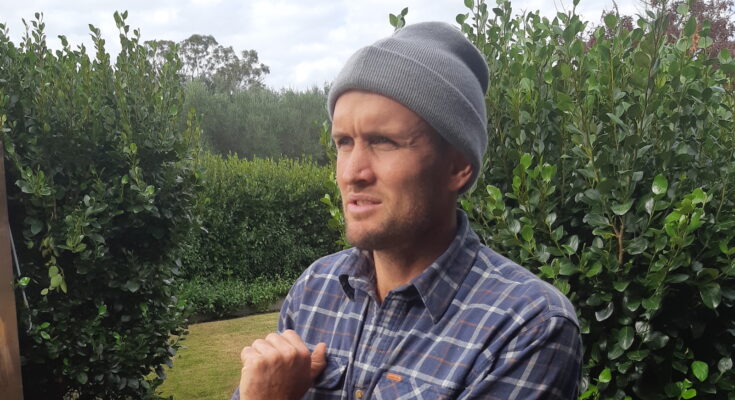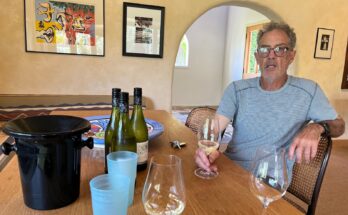I’m a big believer in a personal recommendation. So when a colleague tells me he’s been over to see a small producer in Havelock North, based on a tip from one of our favourite Chardonnay winemakers… and he thinks the wine is pretty good. Well, you can be sure I’ll be getting on that bandwagon. The producer is Village Vineyards, and the bloke in question is Rhys Evans – who I dropped in to see one lunchtime at the beginning of May.
WF: What’s the background to the Village Vineyards label, and what was your personal path to here?
My family has been based in Havelock North for almost 40 years. Orcharding is in our blood. The Village Orchard on Arataki Road was where it started. We grew up there as children and established our farming roots. We enjoyed working the land and after selling up the old orchard, pip fruit wasn’t doing that well at the time, the move up to the vineyard allowed us to continue doing what we love. Subsequently Village Vineyards was born in 2019. The core of the brand is to create unique wines that showcase this one of a kind growing area in rural Havelock North.
I was schooled in Hawkes Bay and through a rugby scholarship decided to stay in the bay post secondary and have a crack at the winemaking and grape growing course at EIT. Upon completion I traveled and worked in a number of regions around the world before settling for four years in BC, Canada. I had a brilliant winemaker and it was a period of great education, particularly around running a small scale wine business. When the sale of 275 Te Mata Road hit the table, this was an opportunity to head home and get stuck into building a small-scale project of our own in the town where we are from. So far it’s been tough but there’s been great moments. We do truly love this work and back the brand, so will forge ahead and see what comes of it.
WF: Tell me a bit more about the vineyard.
RE: It’s a small 1.5 hectare block located at the foothills of Te Mata Peak. It has a clay rich topsoil and shallow subsoil layer of clay that lies on a bed of mud and limestone. The soil warms slowly in the spring but when it does, bud burst is rapid with the canopy reaching the top wire quickly, even by Hawkes Bay standards. We are prone to high mildew susceptibility on the coast so early season canopy management and punctual spray rounds are crucial. If the work is done early in the season then the soil looks after the plants as things warm up. Spring moisture stored in the clay allows us to dry farm into the warm part of summer and there has been little fluctuation in harvest dates.
Our soil does a great job of regulating the fruit’s speed of progression to ripeness. We have three clones in the half hectare portion of Chardonnay. Mendoza, 15 and 95. The Mendoza is always rich and teetering on overripe when we pick while the other clones come into full ripeness. We have all BDX481 Merlot in another half hectare block that makes some Rosé and Red and MS selection Syrah that makes up the remaining half hectare of the vineyard. This Syrah is very versatile. In a dry/hot year we have cropped low and hung it out for a rich, dense barrel of red and in the marginal season picked it earlier for Pét-nat and Rosé as the acid element and red fruit forwardness is always there. I decide what to make around flowering based on volumes and most importantly on how the long range summer conditions are shaping up.
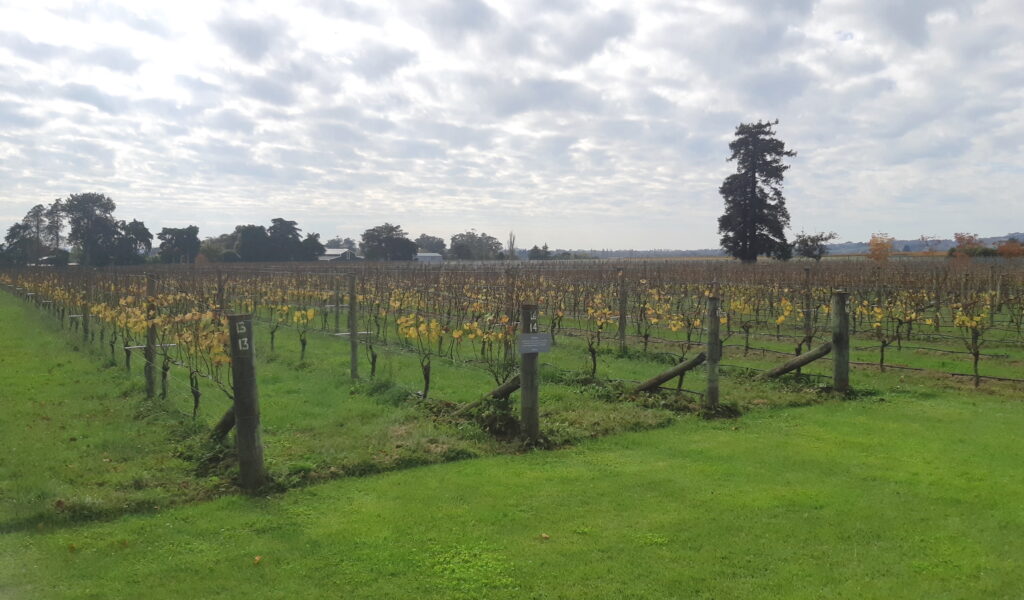
WF: The first thing I want to find out about is the piquette that I hear you’ve been making.
RE: This is it — made from rehydrated skins that we used for the Syrah, for the rosé. I’ve always been a fan of these up in the Pacific Northwest. We made heaps of these in Canada. Just nice and light in an aperitif style. A mid-range alcohol that gives that Craft Beer consumer something to look at.
WF: You have to capture their attention, because otherwise their opinion is “that’s what my Grandad drinks — big, heavy, old dusty reds”. I’ve heard about this and wanted to see what it was about. It is an incredible colour!
RE: People have really warmed to these, as more accessible sparkling wines. I love small batches — that’s us. I’m in no rush to get the skins composted. Especially if there’s a bit left in them – we do a bit of whole bunch pressing for the rosé so there’s still flavour and juice left in those skins. That comes out in that first soak for the piquette. There’s all sorts of ways that you can go with them. You can make them one year and have them sold in the following three months and you’re done. They don’t warrant a huge price tag.
WF: (picks up interesting looking bottle) this is quite funky!
RE: This is the Ancestral Méthode – ‘Snakebite’ is the name of it. We got a bit crazy — foot-stomped, four days, no additions. Dedicated fruit for this which I picked for the acid. With our clay soil we have this real electric, mineral acid in all the fruit. And that really works for making these fun little sparklers. And it also means we can make sulphur-free Pét-nats. Did a Pied de Cuve and wild-fermented it until its dry. And that’s it.
WF: Got a lovely yeastiness to it. Rhubarb, and a mixture of elderberry and elderflower together. Its captured those late summer hedgerow flavours — rosehip, pomegranate, and then some creaminess!!
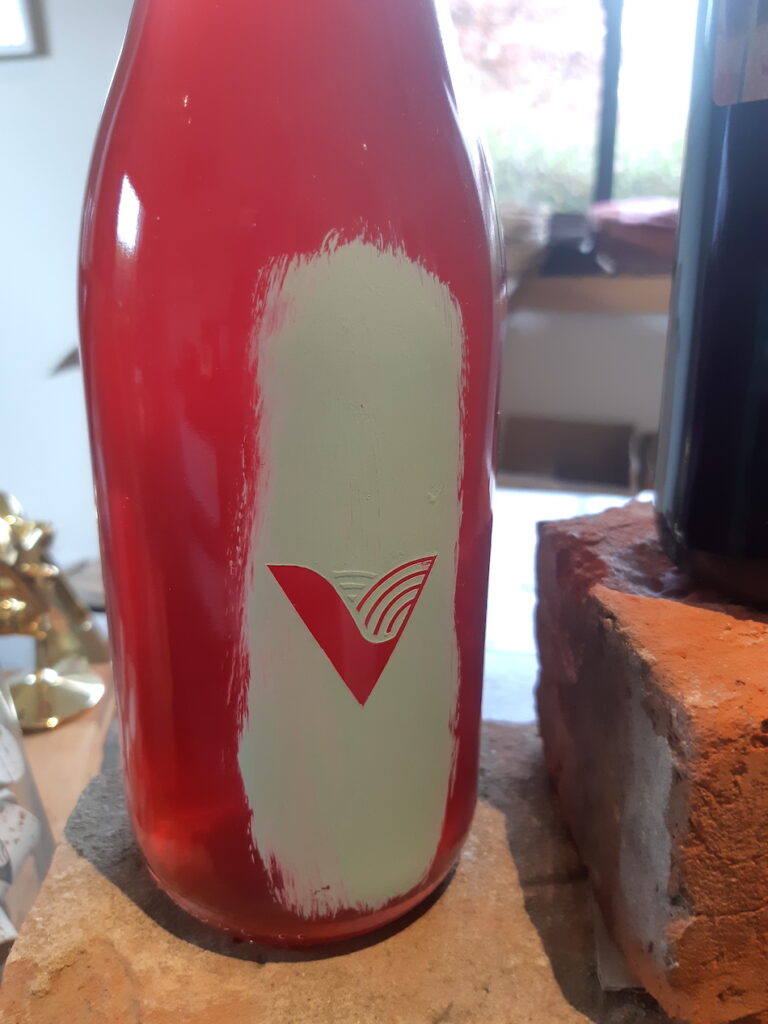
RE: Again, keeping in line with the local feel — the artwork is from our friend, local Abbey Merson. just gave her the brief when it was disgorging — that the wine was full of energy, quite unruly. I possibly bottled it a touch early, that one. We’ve made heaps more of it this year — we went from 150 odd bottles to about 700 of them. With La Nina we could tell early that we weren’t going to have a heavy year with reds, but we’ve got red stocks, so it’s a chance to make more funky stuff.
The rosé is pretty simple. Stainless steel fermented, half whole bunch fermented, half crushed and de-stemmed. Just making a nice clean package. Good acidity. Maybe slightly more extraction than I would have liked. This was the first year using Syrah – the other years have been Merlot, and I’ve learnt quickly that Syrah is pretty quick to give up everything that is in its skins. So we really knocked back that whole crushed, de-stemmed portion.
I’ve never seen rosé as a trend. It’s on the same level as any other dedicated style. It wasn’t until I arrived back in NZ in 2019 that I noticed it had had a reputation here as being dirty and not as serious as other wines. That’s certainly changed now and for the better. At the last winery I worked at in Canada we took it very seriously and grew varieties and applied plans in the vineyard specifically for making premium Rosé. I know what part of our vineyard is best suited for it and I apply that plan from pruning onward.
It’s good being a one-man band, in that I am at the Cellar door, at the coalface — and I found that people are not fazed at all by the colour of rosé. There’s a perception that it’s going to be something sweet and gluggy, but once they try it. It’s not sweet, but its not bone dry either.
WF: if you’d said to me years ago that i’d be drinking a bit of rosé, I’d have said ‘yeah, whatever’ but then, who would have thought we’d have beers that look like milkshakes!? I also had my first sour beer about three years ago. It was Belgian, barrel aged and after I poured I was like ‘what the heck is this’. By the end of it I was thinking it was like I’d never had a beer before..what was that stuff I’d drunk up to now? Really challenging your perceptions.
RE: There’s something about sours, eh? It doesn’t take many. Something about that cleanness of finish. So refreshing. I don’t even mind a bit of brettiness in them.
WF: Hang on, tell me about this?
RE: Our white blend. There’s a bit of fruit that we’ve sourced from out Maraekakaho – some Pinot Gris and some Sauvignon Blanc. It was a great year for the Pinot Gris, and with the Sauvignon everything’s really tropical. We had a light red and I really felt like we needed a white that could work with it. I love having two wines that can work together at the same occasion. The summer white is called ‘Sunset Pool’ and then the light red, and the two artworks work together.
WF: That will work well in our upcoming Top 10 tasting. We’re doing other whites. I’m expecting mostly Chenin Blanc, Albarino, Viognier and a bit of Gruner, but white blends would go down well too. If you wanted to put one in?
RE: Yes, of course. And this is our Chardonnay – all puncheon fermented in old oak. I still like my Chards to look a bit like the place they’re from without too much oak or lees-stirring influence. Maybe a 50/50 split of a wine that’s been worked and wine that’s pure fruit. What we do is go really hard in the vineyard, try and grow good fruit. This property has always had really good acidity, and this wine will continue to soften and develop.
WF: It’s a bit tight at the moment, shy on the nose — but it’s got generosity.
RE: This is the first one that we made. ’21 was about half as much crop. We weren’t here for the pruning in ’19 and ’20, and this property pulled about ten tonnes per hectare before I arrived. And now we’re down to about five. In my opinion it is in way better nick now. It’s like this really fired-up juvenile that hasn’t had boundaries. It’s way less unruly and going hard at pruning time has really helped this vineyard.
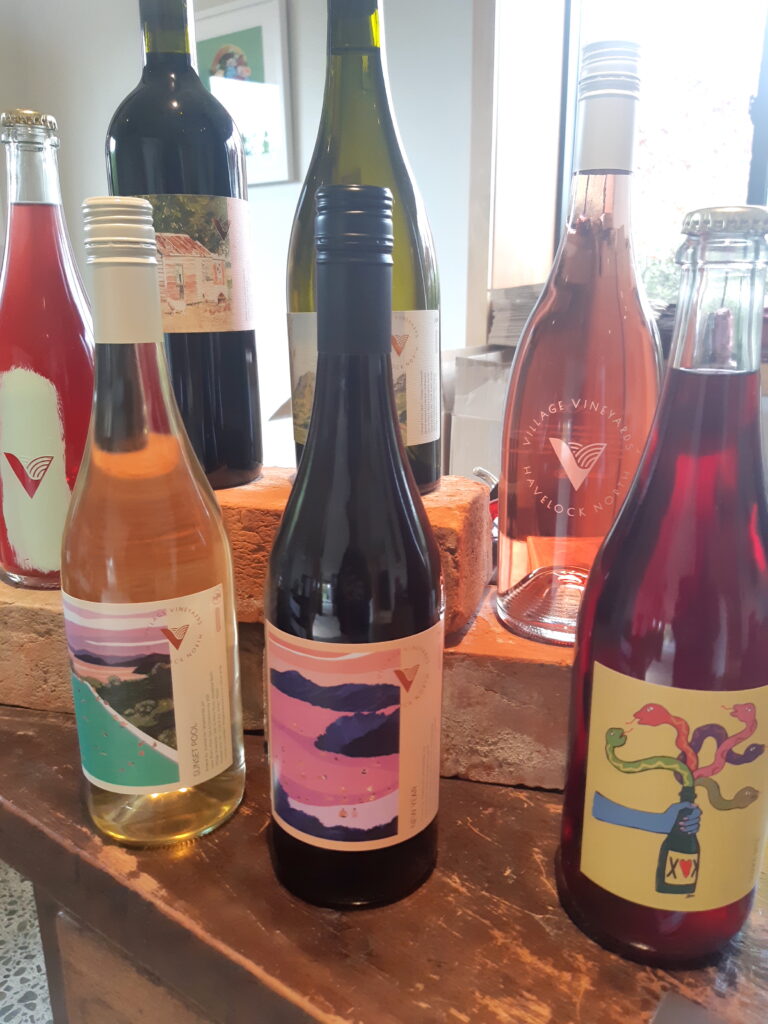
I think the growing conditions in Havelock North are superb for classical Chardonnay. They have a weight that’s quite unique and it doesn’t necessarily come from the winemaking. In their youth they are tight but layers of depth unfold over time which is really pleasing.
Growing wise, spring is challenging and things can grow a foot a day with no shortage of humidity. Farming organically means we have to seriously get on top of canopy density from day dot. We have a heavy clay soil that keeps natural acidity locked in there, and an element of minerality that is present across the board for all our wines. As these soften in the bottle they elicit a wonderful balance of freshness, fruit to oak without the latter dominating, and the tertiary elements. I aim to hit a style that is less heavy handed in the winery. Solids, indigenous ferment, older puncheons, only stirring when necessary, no fining/filtration. I still get excited to experiment in the winery but when you grow the fruit and you’ve put in that effort all year, you just want to get it safely to bottle so that it can reflect all of that effort. It’s a process that’s not too dissimilar to how my parents grew pip and stone fruit many moons ago.
WF: With a few new, smaller labels popping up in Hawke’s Bay – do you see a change in the landscape there — more diversity?
RE: Yes to more diversity. I think the big operators have done a great job with the Hawkes Bay brand over many years and they will continue to do so. The current climate is in my opinion conducive for new, local, edgy brands. Consumerism and the environment, supply chain woes etc. have all made consumers become a bit more engaged with their spending both on what and where. Lots of small brands are getting their message to the consumer exceptionally well and a lot of that is due to the fact that they, the producers, are there at the coal face with the consumer. People are craving the real experiences and that’s what you get when you meet a winemaker or grapegrower that sells their own wine.
I have found in my very short time that if you’re authentic people will get behind it. Proactivity is important, if there’s an opportunity for someone to taste your wine or a restaurant is keen then get there and pour that wine. I’ve found that most consumers are keen to try something new. Maybe this boils down to some degree of monotony in styles and varieties over the past. Nowadays you’re seeing lots of interesting new (slash adopted) wines and styles popping up and no shortage of enthusiasm to try them.
WF: If you could make other wines, what would they be?
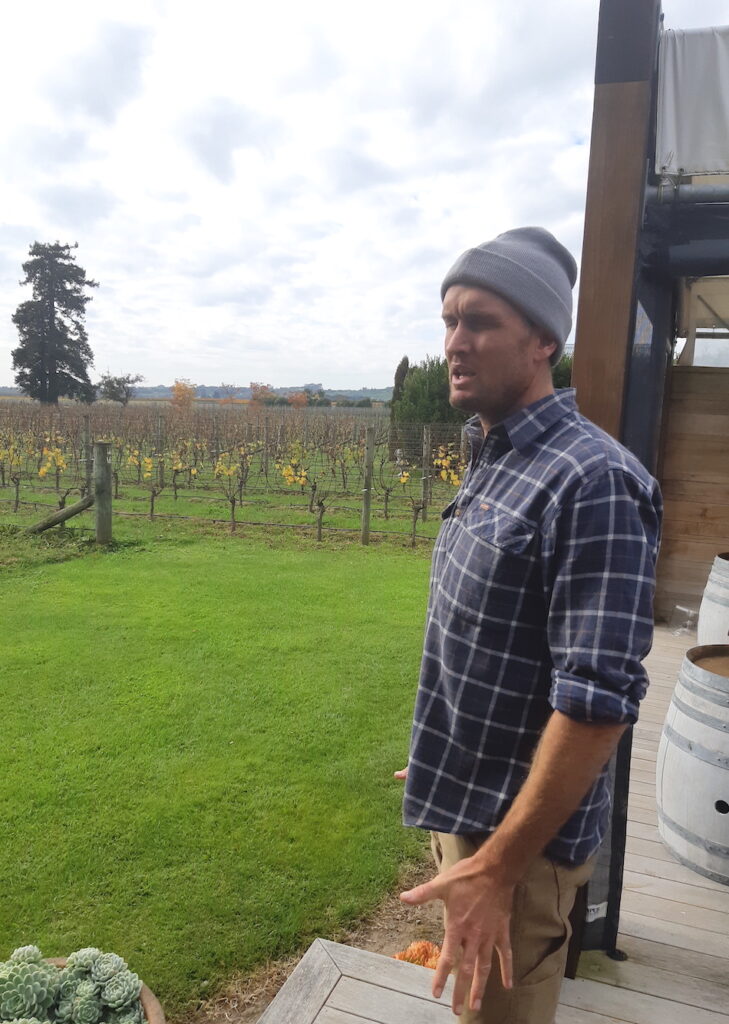
RE: I love our little vineyard and the diversity within it. Without overdoing it we can make excellent Hawkes Bay Barrel fermented Chardonnay and a really quality Merlot. The Syrah can go anyway we want depending on the season so that keeps things interesting. We do have a small quarter hectare piece of fallow land on site that would be great for something else too. I’m into lighter, fruit forward reds. 10 to 12% and drinkable in their youth. Fresh Cabernet Franc and Gamay all day. Wines that are accessible and reasonably priced. I also love semi-skin contacted whites (Muscat/Semillon/Marsanne). Anything that’s juicy and really digestible. Something to think about for the quarter hectare in the future.
WF: Plans for the future?
RE: Very much keeping my head down with Village Vineyards. We have an exciting cellar door project about to begin as well as opening a cafe and eatery. Continuing our remediation work in the vineyard and getting it as healthy and structurally sound as possible. Welcoming in our organic certification in 2023. Continuing to establish valuable, local trade relationships.
WF: Who would you most like to share a glass of your wine with (and why)?
RE: Dave Chappelle. Controversies aside, he strikes me as extremely humble and thought provoking. I think he has some interesting things to say and views on the world and reminds us not to take life too seriously.

